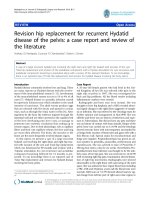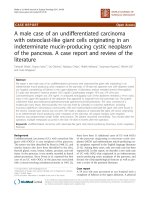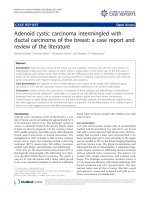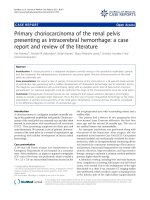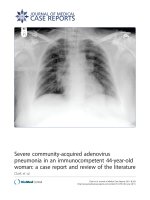Báo cáo y học: " Late-onset erythromelalgia in a previously healthy young woman: a case report and review of the literature" doc
Bạn đang xem bản rút gọn của tài liệu. Xem và tải ngay bản đầy đủ của tài liệu tại đây (201.86 KB, 4 trang )
BioMed Central
Page 1 of 4
(page number not for citation purposes)
Journal of Medical Case Reports
Open Access
Case report
Late-onset erythromelalgia in a previously healthy young woman: a
case report and review of the literature
Shobhana Gaur*
1
and Thomas Koroscil
2
Address:
1
Department of Medicine, Emory University School of Medicine, Atlanta, GA 30322, USA and
2
Department of Medicine, Boonshoft
School of Medicine, Dayton, OH 45408, USA
Email: Shobhana Gaur* - ; Thomas Koroscil -
* Corresponding author
Abstract
Introduction: Erythromelalgia is a rare disorder characterized by episodic erythema and burning
pain, which commonly involves the extremities. We present a case of late onset erythromelalgia in
a previously healthy young woman and briefly review the literature. Our patient's case also has
additional uncommon features not reported previously.
Case presentation: A 33-year-old previously healthy Caucasian woman presented with
complaints of episodic burning pain and flushing occurring in a central distribution involving her
face, ears, upper chest and, occasionally, her upper extremities. Her symptoms were triggered by
lying down or warm temperature exposure and were relieved by cooling measures. Extensive
diagnostic work-up looking for secondary causes for the symptoms was negative and the diagnosis
of erythromelalgia was made based on details provided in her clinical history supported by raised
temperature in the affected area measured by thermography during a symptomatic episode. The
patient did not respond to pharmacological therapy or surgical sympathectomy. She was advised
on lifestyle modification to avoid activities which triggered her symptoms. She was hypothermic
with a core temperature between 92 and 95°F. She also had premature ovarian failure, which had
not previously been reported.
Conclusion: Erythromelalgia is a rare disorder of unknown cause. There is no confirmatory
diagnostic test; diagnosis is based on details provided in the patient's medical history and physical
examination during the episodes. For those affected, this disorder leads to significant long-term
morbidity and unfortunately, to date, no definitive therapy is available except for lifestyle
modification.
Introduction
Erythromelalgia (EM), also called erythermalgia by some
authorities, is often characterized by episodic erythema,
warmth and burning pain in the extremities. EM can be
primary or secondary. Primary EM can be further divided
into familial or sporadic of early (juvenile) or late (adult)
onset. Secondary EM can be due to multiple causes
including but not limited to myeloproliferative or
autoimmune disorders and neuropathic conditions.
Symptoms are triggered by physical exertion or a warm
environment and can be relieved by cooling or elevation
of involved limbs. Episodes may last from minutes to
hours or even days. Early recognition of EM is important
but difficult due to the rare nature of the disorder.
Published: 4 November 2009
Journal of Medical Case Reports 2009, 3:106 doi:10.1186/1752-1947-3-106
Received: 23 December 2008
Accepted: 4 November 2009
This article is available from: />© 2009 Gaur and Koroscil; licensee BioMed Central Ltd.
This is an Open Access article distributed under the terms of the Creative Commons Attribution License ( />),
which permits unrestricted use, distribution, and reproduction in any medium, provided the original work is properly cited.
Journal of Medical Case Reports 2009, 3:106 />Page 2 of 4
(page number not for citation purposes)
Case presentation
A 33-year-old Caucasian woman presented with com-
plaints of episodic burning pain and flushing of her face,
ears, upper chest and, occasionally, her upper extremities.
She presented with photographs displaying bright ery-
thema from her lower neck extending upwards to her face
and head. Her symptoms were precipitated and worsened
with lying down or warm temperature exposure, and were
abated by cooling measures. She maintained her home air
temperature at 60°F. She denied similar symptoms
amongst family members, and there was no family history
of EM. She was in good health until 2001 when she began
to experience these painful burning and flushing epi-
sodes.
Over time, the episodes increased in frequency and sever-
ity until presentation when she was experiencing multiple
daily episodes, each lasting minutes to hours. Her symp-
toms were disabling and she was forced to leave her job.
Physical examinations during multiple visits revealed nor-
mal vital signs except for a reduced core body temperature
of 94° to 95°F. She had dry skin with a diffuse blanching
erythema mainly over her face, and loss of her fingernails.
She underwent an extensive evaluation which included a
normal comprehensive metabolic panel and complete
blood count (CBC) with differential. She did have a low
free thyroxine level with a mildly elevated thyroid stimu-
lating hormone level and was started on levothyroxine for
primary hypothyroidism, but this did not change her
symptoms. Approximately 1 year after the onset of symp-
toms, she developed oligomenorrhea and this later pro-
gressed to amenorrhea. She developed premature ovarian
failure based on low estradiol levels and elevated luteiniz-
ing hormone (LH) and follicle-stimulating hormone
(FSH). Ovarian ultrasound and pituitary magnetic reso-
nance imaging (MRI) were normal. The autoimmune
panel was normal including negative antiperoxidase, anti-
adrenal, anti-ovarian, gastric parietal, antinuclear, anti-
Smith, and anti-DNA antibodies.
Further testing revealed a mildly elevated serum tryptase
level. A skin biopsy was performed, showing nonspecific
changes. A normal bone marrow biopsy excluded sys-
temic mastocytosis or myeloproliferative disorders. She
was started on antihistamines/mast cell stabilizer, but this
did not relieve her symptoms. A trial course of high-dose
steroids was ineffective. She was also treated with intense
pulsed light therapy without any success. Finally, the diag-
nosis of erythromelalgia was made based on her clinical
history supported by raised temperature in the affected
area during an episode, measured by thermography.
Genetic testing was available, but it is not a confirmatory
laboratory test. The patient was offered genetic testing, but
she refused.
Our patient tried several medications including aspirin,
Plavix (clopidogrel bisulfate), selective serotonin reuptake
inhibitors (SSRI), tricyclic antidepressants (TCA), calcium
channel blockers (CCB) and gabapentin. None of these
medicines relieved her symptoms and only clonidine was
temporarily modestly effective. Misoprostol was not sig-
nificantly effective. Surgical sympathectomy was done,
but was similarly ineffective and intravenous gamma
globulin was tried without success. Recently, the patient
has also tried a course of mexiletine. She started with 100
mg twice a day (BID) and this was increased to 200 mg
BID after 2 weeks. She showed no improvement and the
dose was increased 4 weeks later to 200 mg three times a
day (TID). She noted some nausea but no other side
effects. After a month, the dose was further increased to
300 mg TID for 4 weeks. Given the lack of clinical
improvement, mexiletine was tapered and discontinued.
Keeping her at home and very cool provided palliative
relief and reduced the severity and frequency of the epi-
sodes. She pre-cools her car with remote starting during
the summer and then sprints to the car to reduce her expo-
sure to warm air. To date, she continues to avoid any activ-
ity that might precipitate any flushing and burning events.
Discussion
Accurate incidence and prevalence of EM are difficult to
calculate due to the patient's failure to recognize the con-
dition when the symptoms are mild. Physicians may also
fail to make the diagnosis as this is a rare and relatively
unknown disorder. The proposed incidence is 2.5 to 3.3
per million per year with a prevalence of 18 to 20 per mil-
lion in the Norwegian population [1].
In 1878, Mitchell [2] suggested the name 'erythromelal-
gia' because of the characteristic findings of redness
(erythros) and pain (algos) involving the extremities
(melos). Considerable confusion exists regarding the
diagnostic criteria and nomenclature of EM [3]. Unfortu-
nately, there is no confirmatory diagnostic test - the diag-
nosis must be made by taking a careful history, and can be
supported by physical examination during the episodes.
With the advent of digital photography, photographs can
be very helpful to document the events of erythema. Ther-
mography can reveal increased skin temperature in the
affected area, but this is not necessary to establish the
diagnosis.
Once a diagnosis is established, potential secondary
causes must be excluded. CBC with differential is recom-
mended for screening and follow-up. Other causes associ-
ated with erythromelalgia include drugs such as
verapamil, nicardipine, bromocryptine, pergolide, and
mercury poisoning, and diseases such as systemic lupus
erythematosus, Raynaud's disease, pernicious anemia,
thrombotic thrombocytopenic purpura, infectious mono-
Journal of Medical Case Reports 2009, 3:106 />Page 3 of 4
(page number not for citation purposes)
nucleosis and diabetic neuropathy. Appropriate testing
should be considered based on diagnostic suspicion of the
above conditions. Our patient underwent evaluation for
neoplastic, connective tissue and autoimmune disorders
and all results were normal.
The exact pathological mechanism responsible for this
disorder is unknown, but several theories have been pro-
posed to explain its pathophysiology. According to the
microvascular arteriovenous (AV) hypothesis, symptoms
are caused by tissue hypoxia induced by impaired distri-
bution of skin microvascular blood flow with increased
thermoregulatory flow through AV shunts and an inade-
quate perfusion. Work done by Mork and colleagues [4]
supports this hypothesis of increased thermoregulatory
flow through AV shunts during attacks in primary EM.
A prospective study done by Davis et al [5] suggested that
EM is associated with a neuropathy, primarily small-fiber,
and a vasculopathy (intermittent increased blood flow,
AV shunting). There may be increased local cellular
metabolism. However, it is unclear which one is the initi-
ating event or primary abnormality.
An abnormal expression of the sodium channel has been
linked with chronic pain, in particular, the Nav1.7
sodium channel isoform. The Nav1.7 channel is selec-
tively expressed within the dorsal root ganglion (DRG)
and sympathetic ganglia [6,7]. Yang et al [8] reported
mutations in the SCN9A gene, which encodes the Nav1.7
sodium channel, in patients with primary EM. Cummins
et al [9] demonstrated that these mutations in the Nav1.7
channel produce a hyperpolarizing shift in activation and
slow deactivation causing the sodium channels to remain
open for extended periods of time. Overall, these changes
confer hyperexcitability on peripheral sensory and sympa-
thetic neurons, which contributes to symptom production
in primary EM. In 2005, Dib-Hajj et al [10] demonstrated
another F1449V mutation in the Nav1.7 channel, which
also reduces the firing threshold and produces abnormal
repetitive firing in sensory neurons in primary EM. Nearly
a dozen mutations in Nav1.7 have been identified. These
mutations, found to be a cause of familial EM, can pro-
duce a hyperpolarizing shift in the activation of the chan-
nel. Please refer to articles by Dib-Hajj et al [11] and
Drenth et al [12] for reviews on this topic. Lastly, the cause
of sporadic EM remains unknown, however some juvenile
cases reported were thought to be the result of spontane-
ous 'founder' mutations.
A universally effective treatment for EM is unknown. The
mainstay of therapy is support and avoidance of trigger
factors. Local measures include cooling or elevating the
extremity to effectively attenuate or relieve symptoms.
Patients should also be counseled about the use of safe
cooling options such as fans and air conditioning. One
must be careful using ice or immersing an extremity into
an icy water bath to relieve symptoms, since this can lead
to skin necrosis and ulceration.
Several case reports have shown a response to aspirin and
intravenous administration of sodium nitroprusside [13]
and prostaglandins. In secondary EM associated with
myeloproliferative disorders, chemotherapy or phlebot-
omy has been used resulting in improvement of symp-
toms. Surgical sympathectomy has had variable results.
Treatment with medications such as gabapentin, SSRIs,
TCAs, and CCBs has had some symptomatic benefits in a
few cases. One case study [14] reported the efficacy of
sodium channel blockers such as lidocaine and mexilet-
ine, however, our patient's symptoms did not improve
with a trial of mexiletine therapy. She did have temporary
improvement with misoprostol and clonidine, however
beneficial effects were short-lived. She tries to control her
symptom flares by keeping cool and setting her home
temperature to 60°F.
A retrospective study of 168 patients with EM conducted
at the Mayo Clinic showed significant morbidity and mor-
tality [15]. Complications such as digital necrosis, skin
ulceration, extremity gangrene leading to amputation and
nail growth disturbances have been reported in a few
cases. Near fatal hypothermia was reported in a single case
related to constant cooling required to control the symp-
toms. Most concerning is the functional impairment
reported by EM victims, such as inability to walk long dis-
tances, operate a motor vehicle or the inability to continue
in their current job. Our patient remains unable to work
and unable to tolerate any change in environment that
exposes her to warm air.
Our patient's case has additional unusual features. Her
pattern of involvement is mainly the upper chest, neck,
face and head area, as opposed to the usual lower extrem-
ity involvement. She became hypothermic with a core
temperature often in the 92-95°F range. This hypother-
mia is likely due to her chronic exposure and acclimation
to a cool environment at home. An MRI scan of her brain
was normal without any hypothalamic lesion, she had no
other neurologic symptoms, and she hadn't suffered any
head trauma. There was no prior history of body temper-
ature dysregulation or poikilothermia. She had mild pri-
mary hypothyroidism with negative antithyroid
antibodies. Lastly, she also developed premature ovarian
failure, which has not been previously reported. We sug-
gest that her low body temperature may be the cause of
the premature ovarian failure.
Publish with BioMed Central and every
scientist can read your work free of charge
"BioMed Central will be the most significant development for
disseminating the results of biomedical research in our lifetime."
Sir Paul Nurse, Cancer Research UK
Your research papers will be:
available free of charge to the entire biomedical community
peer reviewed and published immediately upon acceptance
cited in PubMed and archived on PubMed Central
yours — you keep the copyright
Submit your manuscript here:
/>BioMedcentral
Journal of Medical Case Reports 2009, 3:106 />Page 4 of 4
(page number not for citation purposes)
Conclusion
Erythromelalgia is a rare disease entity that leads to signif-
icant functional impairment. Our patient had typical and
atypical features of EM. She probably suffered from a non-
inherited form of erythromelalgia. Early recognition of
this disorder and patient counseling are very important in
order to minimize complications. Further research would
be helpful to elucidate the underlying pathophysiology
and to identify effective therapies.
Abbreviations
AV: arteriovenous; BID: twice a day; CBC: complete blood
count; CCB: calcium channel blockers; DRG: dorsal root
ganglion; EM: erythromelalgia; FSH: follicle-stimulating
hormone; LH: luteinizing hormone; MRI: magnetic reso-
nance imaging; SSRI: selective serotonin reuptake inhibi-
tors; TCA: tricyclic antidepressants; TID: three times a day.
Consent
Written informed consent was obtained from the patient
for publication of this case report. A copy of the written
consent is available for review by the Editor-in-Chief of
this journal.
Competing interests
The authors declare that they have no competing interests.
Authors' contributions
SG gathered the data, searched and reviewed the literature
and drafted the manuscript. TK managed the patient, con-
tributed significantly in conception and design, and criti-
cally revised the manuscript. Both authors read and
approved the final manuscript.
References
1. Kvernebo K: Erythromelalgia - A condition caused by microv-
ascular arteriovenous shunting. Vasa 1998, 51(Suppl):1-39.
2. Mitchell SW: On a rare vasomotor neurosis of the extremities
and on the maladies with which it may be confounded. Am J
Med Sci 1878, 76:17-36.
3. Mørk C, Kvernebo K: Erythromelalgia: a mysterious condition?
Editorial. Arch Dermatol 2000, 136:406-409.
4. Mork C, Asker CL, Salerud EG, Kvernebo K: Microvascular arte-
riovenous shunting is probable pathogenetic mechanism in
erythromelalgia. J Invest Dermatol 2000, 114:643-646.
5. Davis MD, Sandroni P, Rooke TW, Low PA: Erythromelalgia: vas-
culopathy, neuropathy or both? Arch Dermatol 2003,
139:1337-1343.
6. Black JA, Dib-Hajj S, McNabola K, Jeste S, Rizzo MA, Kocsis JD, Wax-
man SG: Spinal sensory neurons express multiple sodium
channel alpha subunit mRNAs. Mol Brain Res 1996, 43:117-131.
7. Toledo-Aral JJ, Moss BL, He ZJ, Koszowski AG, Whisenand T, Levin-
son SR, Wolf JJ, Silos-Santiago I, Halegoua S, Mandel G: Identifica-
tion of PN1, a predominant voltage-dependent sodium
channel expressed principally in peripheral neurons. Proc Natl
Acad Sci USA 1997, 94:1527-1532.
8. Yang Y, Wang Y, Li S, Xu Z, Li H, Ma L, Fan J, Bu D, Liu B, Fan Z, Wu
G, Jin J, Ding B, Zhu X, Shen Y: Mutations in SCN9A, encoding a
sodium channel alpha subunit, in patients with primary ery-
thermalgia. J Med Genet 2004, 41:171-174.
9. Cummins TR, Dib-Hajj SD, Waxman SG: Electrophysiological
properties of mutant Nav1.7 sodium channels in a painful
inherited neuropathy. J Neurosci 2004, 24:8232-8236.
10. Dib-Hajj SD, Rush AM, Cummins TR, Hisama FM, Novella S, Tyrrell
L, Marshall L, Waxman SG: Gain-of-function mutation in Nav1.7
in familial erythromelalgia induces bursting of sensory neu-
rons. Brain 2005, 128:1847-1854.
11. Dib-Hajj SD, Cummins TR, Black JA, Waxman SG: From genes to
pain: Nav1.7 and human pain disorders. Trends Neurosci 2007,
30:555-563.
12. Drenth JP, Waxman SG: Mutations in sodium channel gene
SCN9A cause a spectrum of human genetic pain disorders. J
Clin Invest 2007, 117:3603-3609.
13. Ozsoylu S, Caner H, Göklop A: Successful treatment of eryth-
romelalgia with sodium nitroprusside. J Pediatr 1979,
94:619-621.
14. Nathan A, Rose JB, Guite JW, Hehir D, Milovcich K: Primary eryth-
romelalgia in a child responding to intravenous lidocaine and
oral mexiletine treatment. Pediatrics 2005, 115:e504-e507.
15. Davis MD, O'Fallon WM, Rogers RS, Rooke TW: Natural history
of erythromelalgia: presentation and outcome in 168
patients. Arch Dermatol 2000, 136:330-336.
